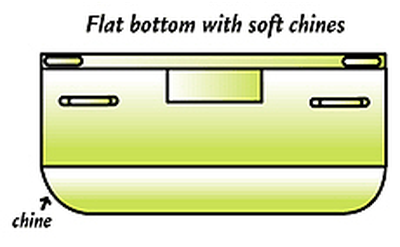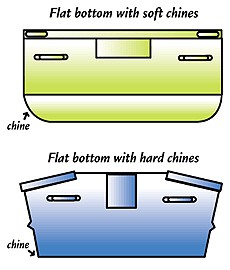Abstract
Sailboats, tugboats, barges, ocean liners, submarines are all different boats with different shapes. How does the shape of a boat's hull affect how easily it moves through the water? This project shows you how you can investigate this question using a homemade water trough and model boat hulls.Summary
Andrew Olson, Ph.D., Science Buddies
Sources
This project is based on:
- Hoover, B.P., 2004. The Shapes of Boat Hulls Matter, California State Science Fair Abstract. Retrieved February 27, 2018.
- SEDL, 1996. "Power Boat Design: A Design Exploration for Upper Level Students," Classroom Compass 2(3): Summer, 1996, Southwest Educational Development Laboratory. Retrieved November 27, 2006.

Objective
The goal of this project is to investigate how the shape of a boat hull affects the drag force on the boat as it moves through the water.
Introduction
Have you ever been to a busy marina and looked at the shapes of the different types of boats moored there? Sometimes you can even find boats entirely out of the water, so that you can see the entire hull. You can see from the smooth lines of a sailboat how it is designed to slip through the water.
Sailboat hulls tend to be long and narrow, with a deep keel to keep the boat from tipping when sailing in a strong wind. They cut easily through the water. Their shape helps to reduce drag, or fluid friction, on the boat as it moves through the water. Dinghies and row boats, on the other hand, have flat bottoms for stability in the water (see Figure 1). When powered with a motor, the ride can be rough if there are waves, since the flat bottom tends to slap on top of the waves rather than cut through them.
 Image Credit: Alex Zidock, Jr / Copyrighted
Image Credit: Alex Zidock, Jr / CopyrightedFlat bottom boats with soft chines have a smooth and rounded transition between the outer wall of the boat and the bottom of the boat. Flat bottom boats with hard chines have a sharp corner between the outer boat wall and flat boat bottom.
Figure 1. Examples of hull designs for flat-bottomed boats (Zidock Jr., 1999).
There are many different hull designs used for small boats. The best design for a particular boat depends on the purpose for the boat, for example fishing, sailing, water skiing, transportation, recreation. This project will help you get started on researching different types of boats. It will also show you how to build some boat models and test how easily each one moves through the water.
Terms and Concepts
To do this project, you should do research that enables you to understand the following terms and concepts:
- Bow
- Stern
- Drag
- Boat hull shapes:
- Flat-bottomed boats
- Vee hulls
- Tunnel vee
- Catamaran
- Tri-hull (or cathedral hull)
- Pontoon
Questions
- From your background research, which hull design do you think will produce the least amount of drag?
- For each hull design, how do you think the drag force will change as the speed of the boat increases?
Bibliography
- This chapter from a boating safety guide introduces boating terminology and design features of different types of boats:
Staff, 2006. The Boat, Boating Basics Online, Nautical Know How, Inc. Retrieved November 01, 2016. - This introductory article on boat hulls include profile illustrations for common sport-boat designs:
- Zidock Jr., A., 1999. "Boat Hull Design," Pennsylvania Angler & Boater, 68 (4, July/August). Retrieved November 01, 2016.
- Advanced students may want to experiment with hull design software to test hypotheses before making physical models. Here is a freely available software package:
- Boatdesign.net, 2015. Michlet Download Page, Boatdesign.net. Retrieved November 01, 2016.
Materials and Equipment
To do this experiment you will need the following materials and equipment:
- Soft wood (e.g., pine) for making boat hulls (2 × 4 lumber is a good starting material)
- Small nails, brads, or cup hooks for fastening string to boat hulls
- Wood carving tools for cutting and shaping the wood
- 1–2 meter length of 4" plastic gutter
- Plastic gutter endpieces
- Garden hose
- Water source
- String
- Spring scale (250 g range should work well) available online from Amazon.com.
Disclaimer: Science Buddies participates in affiliate programs with Home Science Tools, Amazon.com, Carolina Biological, and Jameco Electronics. Proceeds from the affiliate programs help support Science Buddies, a 501(c)(3) public charity, and keep our resources free for everyone. Our top priority is student learning. If you have any comments (positive or negative) related to purchases you've made for science projects from recommendations on our site, please let us know. Write to us at scibuddy@sciencebuddies.org.
Experimental Procedure
Safety Note: Adult supervision is recommended when working with wood carving tools.
- Do your background research so that you are knowledgeable about the terms, concepts, and questions.
- Construct at least four different boat hull shapes from pine or other soft wood. Use the same overall dimensions (length and width) for each design. So that the boat hulls will fit comfortably in the plastic rain gutter for testing, do not exceed 7.6 cm (3") in width.
- Place a nail or cup hook in the center of the top surface of each boat hull. You will use this for attaching the hull to a spring scale for testing.
- Close off both ends of the rain gutter, but leave a small gap at one end for water outflow. Place the garden hose at the other end, and start water flowing.
- Adjust the flow rate of the hose so that the rain gutter is nearly full, with a steady flow of water.
- To measure the drag produced by each hull design, place the hull in the rain gutter with the bow end facing towards the hose end. Run a loop of string from the nail or hook on the hull to the spring scale. Hold (or attach) the other end of the scale to the inlet end of the gutter.
- For each hull, record the reading on the spring scale. Test all of the hulls at the same flow rate.
Ask an Expert
Global Connections
The United Nations Sustainable Development Goals (UNSDGs) are a blueprint to achieve a better and more sustainable future for all.
Variations
- Increase the number of flow rates you use for performing your tests. Test all of the hull shapes at each flow rate. To measure each flow rate, collect the water coming out of the rain gutter, and measure how much you collect in a fixed amount of time (e.g. 30 seconds). Convert your measurement to liters per minute. How does drag change with flow rate for each of the hull designs?
- In the experiment described, you investigated how hull shape affected drag. Here are some other variables you could investigate:
- stern shape,
- length of the boat,
- surface texture of the hull.
- In the experiment described, you measured the boat hulls' resistance to flowing water. Another way to do the experiment is to seal both ends of the gutter and make your measurements by moving the boat through still water. To move the boat, attach a string to the hull and run it over a pulley attached to the end of the gutter. Attach a weight to the string, and let the weight fall to provide the force to move the boat through the water. Note that you will have to raise the gutter up to provide distance for the weight to fall. Time how long it takes the boat to travel from one end of the trough to the other. Hull designs with less drag will have shorter travel times; those with more drag will have longer travel times.
Careers
If you like this project, you might enjoy exploring these related careers:
Related Links
- Science Fair Project Guide
- Other Ideas Like This
- Aerodynamics & Hydrodynamics Project Ideas
- My Favorites










